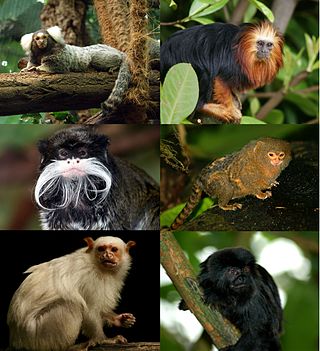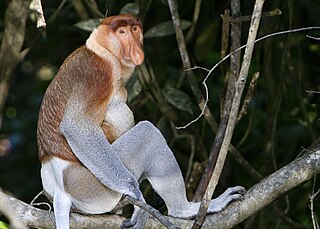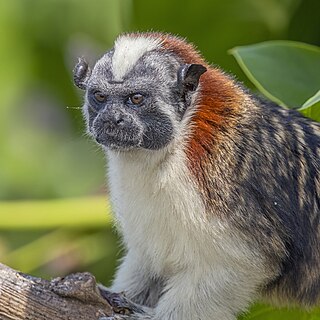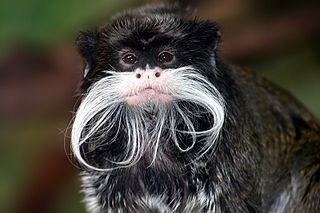
The Callitrichidae are a family of New World monkeys, including marmosets, tamarins, and lion tamarins. At times, this group of animals has been regarded as a subfamily, called the Callitrichinae, of the family Cebidae.

The proboscis monkey or long-nosed monkey is an arboreal Old World monkey with an unusually large nose, a reddish-brown skin color and a long tail. It is endemic to the southeast Asian island of Borneo and is found mostly in mangrove forests and on the coastal areas of the island.

The golden lion tamarin, also known as the golden marmoset, is a small New World monkey of the family Callitrichidae. Endemic to the Atlantic coastal forests of Brazil, the golden lion tamarin is an endangered species. The range for wild individuals is spread across four places along southeastern Brazil, with a recent census estimating 3,200 individuals left in the wild and a captive population maintaining about 490 individuals among 150 zoos.

The pied tamarin, sometimes referred to as the Brazilian bare-faced tamarin, is a critically endangered species of primate found in a restricted area of the Brazilian Amazon Rainforest. It was named the mascot of Manaus, Brazil in 2005. The species is endangered due to the increasing size of the city of Manaus which is encroaching on their native habitat.

Geoffroy's tamarin, also known as the Panamanian, red-crested or rufous-naped tamarin, is a tamarin, a type of small monkey, found in Panama and Colombia. It is predominantly black and white, with a reddish nape. Diurnal, Geoffroy's tamarin spends most of its time in trees, but does come down to the ground occasionally. It lives in groups that most often number between three and five individuals, and generally include one or more adults of each sex. It eats a variety of foods, including insects, plant exudates, fruits and other plant parts. Insects and fruits account for the majority of its diet, but exudates are also important. But since its teeth are not adapted for gouging trees to get to the sap, it can only eat exudates when they are easily available.

Pygmy marmosets are two species of small New World monkeys in the genus Cebuella. They are native to rainforests of the western Amazon Basin in South America. These primates are notable for being the smallest monkeys in the world, at just over 100 g (3.5 oz). They are generally found in evergreen and river-edge forests and are gum-feeding specialists, or gummivores.

The tamarins are squirrel-sized New World monkeys from the family Callitrichidae in the genus Saguinus. They are the first offshoot in the Callitrichidae tree, and therefore are the sister group of a clade formed by the lion tamarins, Goeldi's monkeys and marmosets.

The cotton-top tamarin is a small New World monkey weighing less than 0.5 kg (1.1 lb). This New World monkey can live up to 24 years, but most of them die by 13 years. One of the smallest primates, the cotton-top tamarin is easily recognized by the long, white sagittal crest extending from its forehead to its shoulders. The species is found in tropical forest edges and secondary forests in northwestern Colombia, where it is arboreal and diurnal. Its diet includes insects and plant exudates, and it is an important seed disperser in the tropical ecosystem.

The sooty mangabey is an Old World monkey found in forests from Senegal in a margin along the coast down to the Ivory Coast.

The mantled guereza, also known simply as the guereza, the eastern black-and-white colobus, or the Abyssinian black-and-white colobus, is a black-and-white colobus, a type of Old World monkey. It is native to much of west central and east Africa, including Cameroon, Equatorial Guinea, Nigeria, Ethiopia, Kenya, Tanzania, Uganda and Chad. The species consists of several subspecies that differ in appearance. It has a distinctive appearance, which is alluded to in its name; the long white fringes of hair that run along each side of its black trunk are known as a mantle. Its face is framed with white hair and it has a large white tail tuft.

The black lion tamarin, also known as the golden-rumped lion tamarin, is a lion tamarin endemic to the Brazilian state of São Paulo, almost exclusively at the Morro do Diabo State Park. Its limited geographical range makes it the rarest of the New World monkeys, with little known about it. It was thought to be extinct for 65 years until its rediscovery in 1970. In 2016 an adult couple was found to the east, in the Caetetus Ecological Station, after six years with no sightings.

The black tamarin or western black-handed tamarin is a species of tamarin endemic to Brazil.

The moustached tamarin is a New World monkey and a species of tamarin. The moustached tamarin is named for the lack of coloring in the facial hair surrounding their mouth, appearing similar to a moustache. As with all New World monkeys, the moustached tamarin is found only in areas of Central and South America.

The brown-mantled tamarin, also known as Spix's saddle-back tamarin, is a species of saddle-back tamarin. This New World monkey is found in the Southern American countries of Bolivia, Brazil and Peru. This omnivorous member of the Callitrichidae family is usually found in smaller groups ranging between 4 and 15 individuals. This species communicates vocally and largely rely their olfactory system. The brown-mantled tamarin is considered as a species of Least Concern by the International Union for Conservation of Nature, despite a decreasing population and being threatened by poaching, habitat loss and capture for the illegal pet trade.

The golden-mantled tamarin is a tamarin species from South America. It is found in Ecuador and Peru, specifically in the upper Amazon (lowland), east of the Andes in Ecuador, and Northeast Peru; between the Rio Curaray and Rio Napo in Peru.
Paul Garber is a primatologist and the author and editor of several books and articles about primates. He is a professor at the University of Illinois. He is editor of the American Journal of Primatology and director of research and education at La Suerte Biological Field School in Costa Rica. Books he has authored or edited include New Perspectives in the Study of Mesoamerican Primates: Distribution, Ecology, Behavior, and Conservation , On the Move: How and Why Animals Travel in Groups, Adaptive Radiations of Neotropical Primates. and South American Primates: Comparative Perspectives in the Study of Behavior, Ecology, and Conservation In 2014, he co-edited two books on howler monkeys. He has also studied interrelationships between the moustached tamarin and the saddleback tamarin.

The bearded emperor tamarin is one of the two subspecies of the emperor tamarin. It is mostly found in the tropical forests of southwestern Brazil and eastern Peru. This omnivorous member of the Callitrichidae family is usually found in groups of 4 and shares social relations with other callitrichids. They communicate vocally, as well as with olfactory signals. Males tend to be primary caregivers for their young. It is considered as a species of Least Concern by the IUCN, despite threats from increased habitat loss.

The saddle-back tamarins are squirrel-sized New World monkeys from the family Callitrichidae in the genus or subgenus Leontocebus. They were split from the tamarin genus Saguinus based on genetic data and on the fact that saddle-back tamarins are sympatric with members of Saguinus to a greater extent than would be expected from two members of the same genus. However, this argument can be circular, as several other mammals show sympatry among congeneric species, such as armadillos, spotted cats, and fruit-eating bats. Some authors still consider Leontocebus to be a subgenus of Saguinus.

Geoffroy's saddle-back tamarin is a species of saddle-back tamarin, a type of small monkey from South America. Geoffroy's saddle-back tamarin was formerly considered to be a subspecies of the brown-mantled tamarin, L. fuscicollis. It lives in Loreto, Peru.

Primate sociality is an area of primatology that aims to study the interactions between three main elements of a primate social network: the social organisation, the social structure and the mating system. The intersection of these three structures describe the socially complex behaviours and relationships occurring among adult males and females of a particular species. Cohesion and stability of groups are maintained through a confluence of factors, including: kinship, willingness to cooperate, frequency of agonistic behaviour, or varying intensities of dominance structures.




















